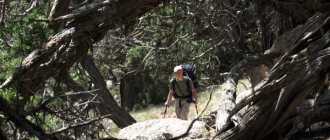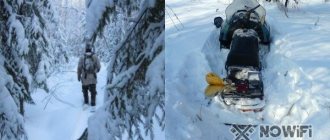A selection of rules for survival in the forest (jungle)
But, unfortunately, as practice shows, in everyday life any of us can find ourselves in such a “beautiful paradise” place and simply get lost. What do you need to know to protect yourself, family or friends? Rules for survival in the forest, advice from experienced travelers.
Moving through the forest (jungle)
If suddenly it happens that you get lost or are left alone in the tropical wilds, the main thing is not to panic! Assess the whole situation, relax, plan your actions.
- If possible, you need to navigate the area;
- determine what supplies of water and food you have;
- Your path should be laid in one direction, but not in a straight line.
Remember, you have a long way to go to your desired destination and every hour you must rest for 10-15 minutes to recuperate. After 5-6 hours, the break should be at least an hour.
Choosing a habitat
If your location is in impenetrable thickets (or in the forest), it is better to find a place to spend the night at a higher and more airy place so that you are not bothered by insects and other animals.
- 11 facts about tourism that will convince you to urgently pack your bags for a trip
Your “house” must have at least some kind of roof and bed. For the roof, you can use a parachute (what if you bring it with you) or palm leaves.
- To prevent palm leaves from allowing moisture to pass through, they must be “fried” on stones; they will become darker and glossier.
- Don’t forget about the bed; it can be easily made from bamboo or any twigs.
Without water, neither here nor there! The main thing in survival in the forest (jungle)
Water and jungle are very compatible things, but you should be very careful when choosing sources!
- water from a stream will do, even better where there are rocks
- Boil it before use
Independent mining
You need to dig a hole to 6 feet from the edge of the stream or lake bank, then wait for the water to seep in and settle.
Extraction from fruits or other plants
Such sources can be: grapes, coconut, bamboo shoots or sugar syrup from flower threads.
Jungle types
14-5. standard jungle . Tropical areas can take any of the following forms:
- Tropical rain forests.
- Secondary jungle.
- Semi-evergreen seasonal and monsoon forests.
- Tropical shrubs and dwarf thorny thickets.
- Savannah.
- Salt marshes and swamps.
- Freshwater swamps and swamps.
Tropical rain forests
14-6. In tropical forests the climate is not particularly changeable. They are located on the equator in the Amazon and Congo basins, Indonesia and several Pacific islands. Every year, up to 3.5 meters of precipitation falls there in the form of rain. Temperatures range from 32 degrees during the day to 21°C at night.
14-7. This jungle five layers of vegetation (Figure 14-1). In areas untouched by humans, trees grow up to 60 meters. Below are smaller trees that make up a kind of canopy, so dense that almost no sunlight reaches the lower tiers. Seedlings fight for light, a mass of weaving plants and vines reaches towards the sun. Ferns, mosses and grasses push through the thick foliage, and a wide variety of fungi grow on leaves and fallen trees.
Figure 14-1. Five tiers of rainforest
14-8. Due to the lack of light in the lower layers of the jungle, the small undergrowth does not greatly impede movement, however, dense vegetation limits visibility to 50m. When surviving in such a jungle, it is easy to lose your sense of direction, and it is also difficult to be detected from the air.
Secondary jungle
14-9. Secondary jungle is very similar to tropical forest. They are characterized by intensive growth of vegetation where sunlight penetrates the lower tiers. This occurs mostly along river banks, at the edges of rainforests, and in areas where the jungle has been cleared by humans. Dense plant mass grows quickly in abandoned areas. Here, among such vegetation, you can find edible or cultivated plants.
Semi-evergreen seasonal and monsoon forests
14-10. American and African semi-evergreen seasonal forests are very similar to the monsoon forests of the Asian continent. They are characterized by the following:
- The trees are divided into two tiers. The upper tier is 18-24m; lower – 7-13m.
- The average diameter of tree trunks is 0.5 m.
- During the dry season, the leaves on the trees fall off.
14-11. In such forests, the same edible plants grow as in rain forests, except for palm trees: coconut and nipa.
14-12. Such forests are found in parts of Colombia and Venezuela, as well as in the Amazon Valley of South America; in parts of the southeast coast of Kenya, Tanzania and Mozambique in Africa; in northeast India, most of Burma, Thailand, Indochina, Java and other Indonesian islands of Asia.
Tropical shrubs and dwarf thorny thickets
14-13. Main features of tropical shrubs and dwarf thickets:
- These areas have a pronounced dry season.
- During the dry season, the leaves on the trees fall off.
- The ground is bare except for some areas where plants grow in groups. The grass is rare.
- Thorny plants predominate.
- Fires occur frequently.
14-14. Tropical shrub and dwarf thickets predominate on the west coast of Mexico, the Yucatan Peninsula, Venezuela and Brazil; on the northwest coast and in the central regions of Africa, Asia, Turkestan and India.
14-15. Being in such thickets during the dry season, it is difficult to find edible plants. During the rainy season they are in abundance.
Tropical savannas
14-16. General characteristics of the savannah -
- Found in the tropical zones of South America and Africa.
- They resemble a wide grassy meadow with sparse trees.
- They often have red soil.
- Rare trees grow, usually small and gnarled, like apple trees. Palm trees also grow in savannas.
14-17. Savannas can be found in South America in parts of Venezuela, Brazil and Guyana. In Africa they extend south of the Sahara (northern Cameroon, Gabon and southern Sudan), occupy Benin, Togo, most of Nigeria, northeastern Republic of Congo, northern Uganda, western Kenya, parts of Malawi and Tanzania, southern Zimbabwe and Mozambique and western Madagascar.
Salt marshes and swamps
14-18. Such places are typical of coastal areas subject to tidal influences. Mangroves thrive in them . Mangrove trees reach 12m in height. Their tangled roots impede movement. Visibility in such terrain is limited and movement is extremely difficult. Sometimes rivers that can be rafted form canals. However, you will most likely have to travel through such swamps on foot.
14-19. Such flooded areas exist in West Africa, Madagascar, Malaysia, the Pacific Islands, Central and South America and the Ganges River estuary in India. The swamps at the mouths of the Orinoco, Amazon and Guyana rivers consist of mud and thickets of trees that provide virtually no shade. Tidal levels in such flooded areas can vary by up to 12m.
14-20. In such places, literally everything can seem hostile, from leeches and insects to crocodiles and caimans. Avoid dangerous animals in these swamps.
14-21. If possible, avoid and swamp . If there are water channels running through such areas, you can use a boat to exit them.
Freshwater swamps
14-22. There are freshwater swamps in the lowlands. Characterized by extensive dwarf and thorny vegetation, reed thickets, grass cover, and occasional small palm trees that reduce visibility and impede movement. There are often separate islands that allow you to get out of the water. This area has an abundant fauna.
Getting food. Advice from experienced people
When it comes to food, there are plenty of options for snacks and dinners. But you shouldn’t attack everything at once. Keep your sanity and common sense. Before you start tasting, make sure that the fruit or vegetable you choose is not a disguised poisonous food that wants to encroach on your life.
Check it out! The list of poisonous plants includes:
- - white mango tree;
- - cow bush;
- - dope;
- - Western Celtis;
- - laxative nut;
- - pangi;
- - castor bean.
Fish is an excellent option for breakfast, lunch or dinner. Be careful not to catch something that is dangerous or poisonous to your health. If you understand and are confident in the edibility of a particular fish, then remember:
- It is better to eat fish in small pieces and small portions. If your body responds well to it, then you don’t have to deny yourself any more.
- Fish caught in the jungle quickly spoils; it should be cooked and consumed immediately after catch.
Clothes for traveling through the forest or jungle
What can I say, if you were heading into the jungle, you should have known and taken with you:
- comfortable, practical shoes;
- outerwear with long sleeves and pants to protect against burns and scratches, insect bites or other possible wounds;
- cover your head from the sun (cap, bandana, headband);
Experienced travelers or tourists also know that it is necessary to take replacement shoes and socks.
- What to take with you in your hand luggage?
It’s even better if you have gloves on your hands that will help you overcome the jungle, build shelter and catch fish.
Take care of your health!
The main thing during the whole journey is to stay healthy! During your stay in the jungle you need:
- save energy. When making your way through the thickets, you should take your time, take every step carefully and follow the direction;
- if you get tired, stop and rest;
- If you have a fever or fever, it is strictly prohibited to continue your journey. You need rest and the opportunity to drink more water.
Everything stated above is based on advice and reviews from experienced tourists and should prepare any person to react correctly and calmly to the fact that you may get lost in the forest or jungle. But you should never despair and give up! Now your life and further actions depend only on yourself. Let's look for the positive in any critical situation!
Imagine taking part in the game “Stay Alive” and you will be the winner!
Security
poisonous creatures and parasites in the jungle Also watch your step so as not to step on a snake. Mosquitoes and other insects that are carriers of terrible diseases are also very dangerous If you don’t have a repellent for them, then smear the open areas with mud - good protection against insects. For safety reasons, I found a large stick , which helped me a lot, with its help I cleared my path and defended myself from the monkeys that attacked me.
And yet I survived, and so can you.









